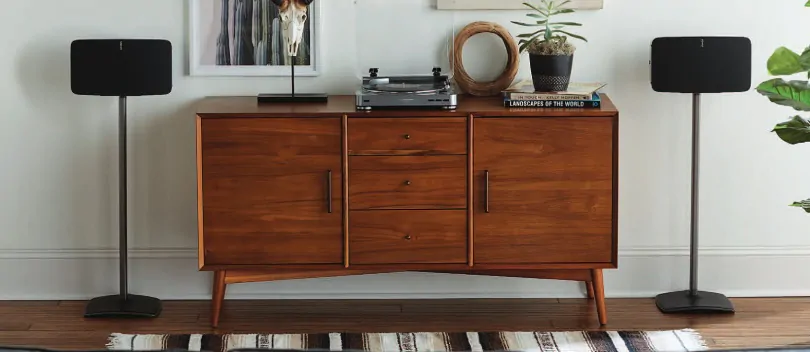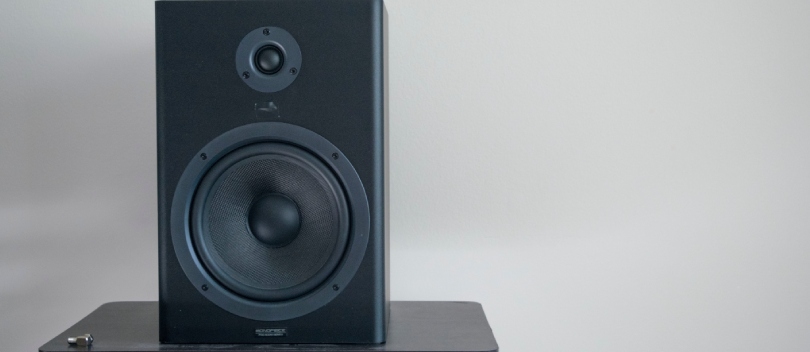
Are you thinking about getting a new speaker stand? Then it's important to know that not only the appearance of a stand matters. The material of your stand can actually make a real difference in how your music sounds. In this blog post, we'll delve into the world of speaker stands and discover together which material can take your audio experience to the next level.
Does the type of material really matter?
When people choose a speaker stand, they often think about design and price, but rarely consider the material it's made of. However, the material of a speaker stand plays a significant role in overall sound quality and experience. For instance, wood is a material frequently used because of its ability to add a warm tone. This is due to the natural resonance of wood, which can help produce a rich and full sound.
On the other hand, materials like concrete and metal tend to reflect more sound, resulting in a clearer and more defined sound. Let's dive deeper into the various types of materials and the effect these materials have on sound.
Types of materials
The material can have a significant impact on a speaker stand. Here, you can learn more about the types of materials:
Wood
Wood, especially hardwood, is often appreciated for its excellent acoustic properties. It can help dampen unwanted vibrations and resonances. The only thing to keep in mind is that hardwood is durable but can be sensitive to moisture and temperature fluctuations.
Concrete
Concrete provides a stable base as a speaker stand and is highly effective at minimizing vibrations and resonances. It can also give your interior a modern and industrial look. However, due to the weight and hardness of the material, it's important to use protective pads.
Metal
Metal can be stronger and stiffer than wood, which can result in fewer resonances. However, some metal stands may transmit vibrations if not well designed or insulated. The main advantage is that metal doesn't rust quickly (especially aluminum) but can scratch or dent upon impact.
Glass
Glass, while attractive, is not the best material from an acoustic standpoint. It can easily resonate. It certainly provides a minimalist and sleek appearance but remains fragile and can quickly shatter upon impact.
Plastic or composite
These two materials can vary in quality and acoustic properties. Generally, they may be less stable than wood or metal. The purchase price of these materials is low, but it also means they can break more easily.
| Material | Interference Potential |
|---|---|
| Wood, synthetic material, glass | Low |
| Water, brick, marble | Medium |
| Stucco, concrete, metal | High |
Vibration Isolation and Damping
Regardless of the material, unwanted vibrations and resonances can negatively affect sound quality. Therefore, it's essential to consider how isolation and damping techniques can contribute to improving the listening experience.
Using spikes or cones under the stands is a popular method to minimize the transmission of vibrations to the floor. These spikes ensure that the stand rests on a very small point, reducing the contact surface with the floor and significantly reducing the transfer of vibrations. This is especially effective on hard floors like wood or tiles.
Another technique is the use of damping pads. These pads, often made of rubber or other absorbent material, are placed between the speaker and the stand. They act as shock absorbers, absorbing vibrations and preventing them from being transmitted through the material of the stand.
Eliminate Disturbances
It's important to consider the environment of the speaker stand. Soft materials absorb sound, while hard materials reflect it. In an empty space, you'll hear sound reverberate, leading to a distorted playback. Try to avoid or minimize disruptive elements such as large metal objects or surfaces that can reflect sound. Through strategic placement and selecting the right material, you can elevate sound quality.

3 More Tips for Optimal Sound
Not only does the type of material on which you place your speaker stands contribute to sound, but also where you position the speakers and the materials present in the room significantly impact how you perceive sound. So, be sure to follow these tips:
Tip 1: Ensure Free Space Around the Speakers
It's essential to place your speakers at some distance from the walls to control vibrations. When speakers are too close to a wall, in a corner, or inside a cabinet, early reflections occur. These reflections result in a rapid succession of two sound waves, disrupting sound quality. Experiment with different speaker positions and distances from your listening position to find the ideal setup.
Tip 2: Position the Speakers at Ear Level
For an optimal sound experience, it's recommended to position the speakers at ear level. When using smaller speakers, a speaker stand can be helpful. These stands not only make it easier to move the speakers but also ensure they are at the right height. This promotes the perception of high tones, which mainly propagate horizontally and are best heard at ear level.
Tip 3: Determine the Right Speaker Placement
When placing multiple speakers, it's important that they are at an equal distance from each other and from your listening position. Avoid placing the speakers too far apart to ensure all tones remain audible, especially if you are positioned between the speakers. Point the speakers towards you and discover the angle that is most comfortable for you. In a stereo setup, it's crucial that both speakers are turned inward at the same distance. For a more powerful bass sound, you can place the speakers closer to the wall.
Order Speaker Stands? Check Out Our Assortment
For those seeking high-quality speaker stands, you should definitely take a look at our extensive assortment. At Vebos, you can find a wide range of speaker stands specifically designed for various renowned brands.
Whether you need a stand for a compact speaker or a more robust setup, Vebos offers a customized solution that perfectly suits your specific needs and the unique characteristics of your audio system.
